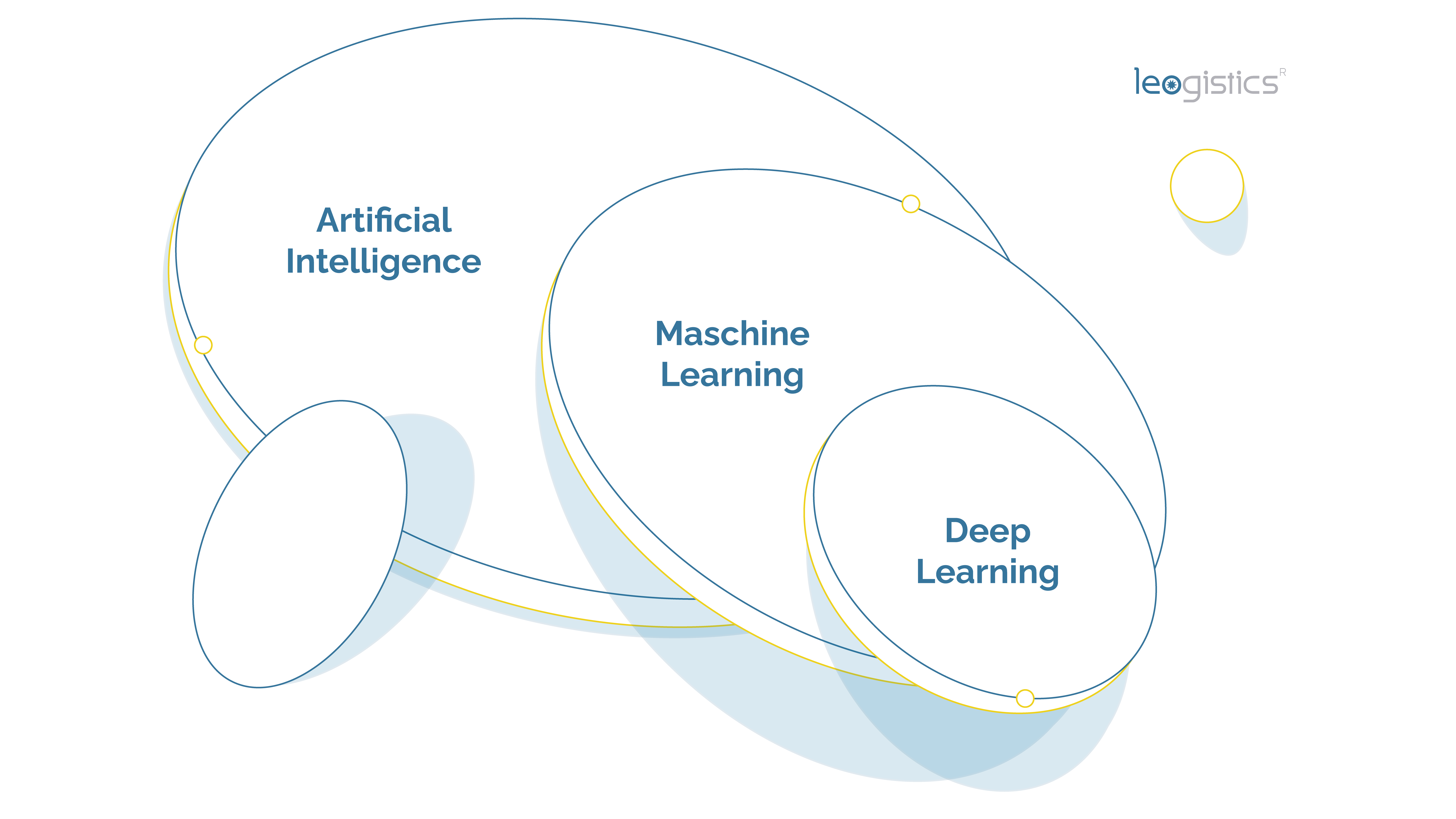Artificial intelligence Makes Proactive Predictions About Logistics Processes
Basically, we all strive to always use the most appropriate technology to solve our problems. The logistics world in particular, with its high demands on efficiency and high competitive pressure, is therefore always interested in new possibilities for optimisation.
A brief overview of AI, machine learning and deep learning
The field of artificial intelligence also includes machine learning and deep learning. The following diagram illustrates how these areas relate to each other.

In classical programming, one explicitly programmes the rules according to which data is to be processed. And this is also sufficient in many situations.
In transport logistics tasks, however, a large number of variables influences the optimal process flow, which makes an effective solution with predefined rules much more difficult. This is where machine learning comes into play. So, if the processes are too complicated to be described with fixed rules, it makes sense to take a closer look at this technology. At leogistics, we have the ambition to optimise logistics processes with the help of AI.
Machine Learning
The fascinating thing about machine learning is that the system is not explicitly programmed, but trained with very many examples (data).

In simple terms, the data to be processed and the desired answer(s) or results are fed into the system. The system gradually finds statistical structures in the data and creates corresponding rules. It is precisely these rules that can then be used to make evaluations about the data that the system has never seen before.
Deep Learning
Deep learning is a specific subfield of machine learning. It forms a new view of learning representations from data that focuses on learning successive layers of increasingly meaningful representations. Today’s deep learning models consist of dozens or even hundreds of successive layers of representations that are automatically trained with the data. These are usually trained using models also known as “neural networks”, which are very common in image recognition, for example. Perhaps the most prominent example of this is the unlocking of the mobile phone via Face ID.
The importance of AI in logistics
Logistics processes generate huge amounts of data every day. Why shouldn’t this data be used to put AI systems into operation? This makes it possible to optimise the timing of manual or already automated processes, for example – the myleo / slot time slot booking system already achieves efficient control and planning of loading and unloading at the loading bay. New methods and behaviours can also be defined, which in the best case turn reactive processes into proactive ones. For planning reliability, this would mean concrete predictions for the future instead of guesses or estimates.
The use of AI systems thus promises new possibilities and potential for increasing productivity and efficiency and reducing costs. However, there are also obstacles that need to be taken into account. The lack of specialists and skilled workers remains a well-known problem, and the concern of employees that AI systems could threaten their professional existence should not go unnoticed.
Once these hurdles are overcome, however, users have a wide range of opportunities to optimise the workflows and processes of the entire supply chain.
The applications that are already possible today are being established
Affordable, powerful hardware, fast networks and storage options in the cloud are already helping AI applications to become widespread. Without a doubt, the extensive use of artificial intelligence in logistics is still in development and will only be able to exploit its full potential in the next few years. To date, however – and not without reason – a number of application possibilities have already become established.
Case studies
Planning consumption intentions ahead through AI
For example, it is possible to make predictions about the consumption intentions of end customers. If data from sales statistics and/or social networks are included in the planning, overstocking or even stock shortages can be avoided and ultimately costs can be saved.
Flexibly adapting warehousing thanks to AI
Warehousing at larger companies is also now automated and AI-supported by reacting to changes in typical tasks and flexibly adapting the following processes. For example, the technology recognises goods that are frequently stored and retrieved and places them closer to the beginning of a shelf, thus saving distances and valuable time.
“An AI-system can only learn what it is trained with. If the data is inaccurate, it will not be able to make confident statements.”
Mirko Hartig
Furthermore, correlations can be found in data concerning the quality of products or services. The newly derived metrics can then lead to further quality or service improvement. To put it simply, who would have thought two years ago that working from home would reduce the number of sick days? An AI, had it been trained with the relevant data, could have predicted this.
AI-supported optimisation of truck supply and maintenance
Systems that predict the estimated time of arrival by observing telemetry data of a vehicle at a specific destination are also widely used. This data is used for predictive maintenance. It is better to do repairs before damage occurs. This reduces maintenance costs, makes maintenance times plannable and increases reliability.
Planning warehouse door utilisation with foresight through object recognition
The deep learning technology mentioned further above, i.e. visual AI, can be used for object recognition. This enables, for example, fully automated goods receipt without the need for bar or QR codes. Products, dimensions, weight or damaged cartons have become identifiable, measurable and countable with this technology. Another possibility is to have loading gates monitored by a camera, as is the case with one of leogistics’ customers. Here, object recognition identifies which gate is vacant or occupied and also enables better planning and utilisation of the gates.
A look into the future - science fiction or reality?
In the next few years, logistics will certainly be supported by data glasses. Increasingly, goods will be moved around warehouses by autonomous vehicles. Autonomous drones could take over inventories. However, there is still a long way to go before delivery robots bring the products to the end customer’s door. But the beginnings have been made! Every step in the direction of “machines earning money for us (as a society)” – no matter how small – is a step in the right direction.
We are here for You!
Once you have recognised that learning systems are created with the input data and the desired answers and that the rules for data processing result from this, then you are in a position to optimise, if not revolutionise, your logistics processes!
It is therefore worth taking a closer look at AI, using new technologies and thus also saving significant money. Are there still some points that remain open for you? For more clarity, please contact us. If you have any questions about this or other topics in the blog, please contact blog@leogistics.com.
Mirko Hartig,
Associate Technical Consultant IoT & Automation
Successful Application Development with Design Thinking
Our Straightforward Customer Service For Your Concerns
The Future of Yard Management: Contactless And Digital Yard Management
Container management: Do you still have all containers in stock?
Transportation management systems are changing
How to overcome obstacles!
I develop a voice assistant for digital logistics solutions
How to optimize the check-in and check-out process
Goodbye Scheduling Chaos: Stay On Top Of Things
BLOG &
NEWS
Latest news and blog posts from the world of intelligent supply chain management.












